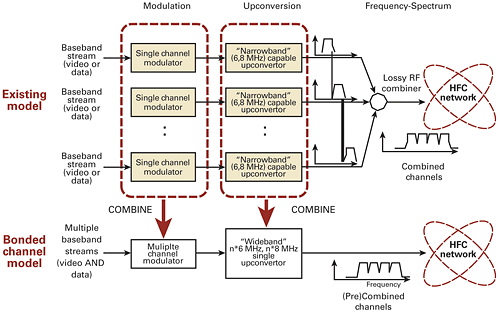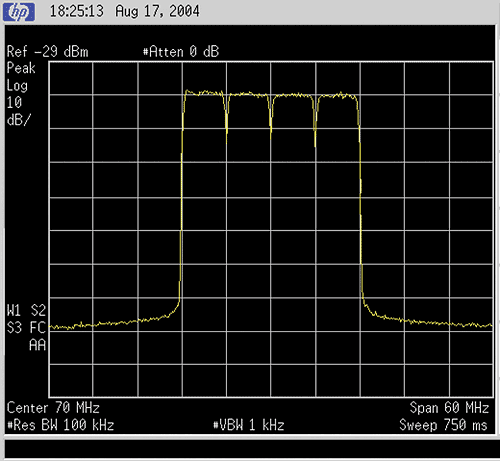Channel Bonding
Editor’s note: Shortly after this article was written, CableLabs selected packet-based channel bonding, which this article describes, for DOCSIS 3.0. Advanced, converged multimedia services such as video conferencing, network gaming and interactive TV are facilitated in cable networks by additional downstream bandwidth. The Data Over Cable Service Interface Specification (DOCSIS) provides an excellent platform for adding downstream bandwidth on hybrid fiber/coax (HFC) networks in a technically effective and economically viable way, when the concept of quadrature amplitude modulation (QAM) channel bonding is introduced. Two or more QAM channels are grouped together in an adjacent frequency range, such that they share the same upconversion and other hardware stages, reducing hardware cost in the cable modem termination system (CMTS). Channel bonding also provides an economic option for greater than 100 Mbps customer premises equipment (CPE) throughput, without plant upgrades. Headend and access-side silicon solutions are becoming available to enable cable to compete with advanced digital subscriber line (DSL) and other alternative broadband services. Similarities in specification between digital video and DOCSIS downstreams can be leveraged to provide devices that can simultaneously transport native digital video as well as Internet protocol (IP) traffic, enabling operators to bundle multimedia services using common access devices. Target services and DOCSIS Satellite has appeared as a compelling option to subscribers for TV service. Broadband over satellite is also viable, though only for services where return path transmission delay in particular is not an issue. DSL technology has evolved to the point where, depending on distance of the subscriber’s premises from the DSL access multiplexer (DSLAM), bit rates of more than 50 Mbps are technically possible and economically viable. Telcos now provide a potent threat, especially since low latency voice, data and video services can also be provided via DSL on twisted-pair lines. The bundling of data, voice and video services over coaxial networks is still an attractive business proposition to attract new customers to cable operators and reduce churn. Additional services can also be offered economically, to enhance the bundle. For example: The common denominator in many of these services is the need for higher available downstream bit rates. For example, consider the case of a future deployment with voice over IP (VoIP, G711 codec based), high-speed traffic (1 Mbps down, 256 kbps up), a high-speed movie download to a PVR-based home-movie system and a video over IP VOD service. Assume concurrent video usage peaks after an evening meal. Table 1 assumes a fiber node size of 500 homes passed and calculates bit rate utilization, assuming service penetration and concurrent usage. Compare these numbers with a typical DOCSIS configuration. A 64-QAM 6 MHz downstream will deliver about 28 Mbps net throughput. A 16-QAM 3.2 MHz upstream channel will deliver about 8-9 Mbps net. For the traffic above, two downstream channels and one upstream channel are required, whereas a typical CMTS configuration has a 4:1 or 6:1 upstream:downstream port ratio, the inverse of what is needed. Packet-Cable 1.x supports VoIP and builds upon the quality of service (QoS) and high throughput supported by DOCSIS 2.0. PacketCable Multimedia (PCMM) is an evolutionary extension to support video and other multimedia services. This article proposes QAM channel bonding of DOCSIS downstreams as a mechanism to increase downstream bandwidth for multimedia services over the coaxial section of the access infrastructure. Together, DOCSIS and PacketCable then provide the building blocks for advanced multimedia service bundles to attract and retain customers. Channel bonding concept Digital video and DOCSIS downstream channels share common downstream channel inband characteristics (ITU J.83 Annex-B for North American 6 MHz, Annex A for European 8 MHz channelization). In particular, the modulation (channel coding) and upconversion technologies are common. It is also quite typical that an operator will allocate the outputs of many channels that carry similar content (such as video or data) to be contiguous in frequency. This begs the question, is there a better way to create these channels that leads to both lower cost and better RF characteristics? Channel combining, using the concept of bonded channels, is a straightforward and economical means of achieving these goals. (See Figure 1.) In the unbonded case, DOCSIS data and digital video streams are carried at baseband as a Moving Pictures Experts Group (MPEG) formatted sequence of data. This data format must then be converted into a form that can be transmitted on the coaxial cable, via modulation and upconversion. Modulation: The baseband signal is transformed such that it can withstand the noise and other degradation characteristics inherent in coaxial cable networks. It is then converted into a sequence of QAM symbols that, when modulated and filtered, will occupy a certain limited frequency band. This process is almost entirely high-speed digital in nature, though the final digital stream is then usually converted to analog by a D/A converter at a conveniently lower intermediate frequency (IF). Since modulation is implemented primarily in the digital domain, it is a prime candidate to take advantage of higher density digital logic. Channels are combined digitally, such that only one D/A conversion component is needed to create an analog output. This lowers costs and power consumption and increases hardware density. Upconversion: The IF output of the modulator is transformed such that it then occupies a unique frequency band on the coaxial cable, programmed by the operator. The process is usually analog in nature, though the emphasis is now shifting toward direct digital synthesis or direct RF approaches. Multiple QAM channels can be upconverted in already digitally precombined groups, using only one RF upconvertor lineup. Extensive tuning of the design is needed, including use of wider band components (in particular standing acoustic waves, or SAWs), paying particular attention to distortion and compression effects. (See Figure 2.) Again, space, cost and power consumption are reduced. Other approaches might include higher symbol rates while maintaining J.83 channel coding or use of a new modulation approach, such as ultra wideband or orthogonal frequency division multiplexing OFDM). Unfortunately, such alternatives lack backward compatibility with currently deployed set-tops and cable modems. Relative costs A DOCSIS "downstream" carries a higher price than the equivalent QAM modulator and upconvertor for digital video, even though these use similar technologies. However, a DOCSIS headend has quite a number of additional value-adding functions besides downstream signal conditioning, including: In effect, a DOCSIS CMTS for data services can be equivalent to a router, statistical multiplexer and return-channel headend for video services, integrated in one device. Channel bonding may be applied to a DOCSIS CMTS in order to increase the downstream capacity available by addition of extra downstream channels. It is worthy of note that the cost of a multi-downstream CMTS does not increase proportionately with the number of downstreams since most of the other elements are unchanged. When the costs of other system level components are included, a DOCSIS CMTS with integrated channel bonding can be shown to provide a cost-effective and operationally efficient mechanism for provision of future multimedia services. Applying DOCSIS to bonded channels There are no RF standards applied to digital video delivery, except those generally accepted as industry practice. DOCSIS provides a tough specification for downstream RF, insisting on: RF issues to be considered in a bonded downstream deployment include maximum number of QAM channels, maximum output power equivalence and flexibility to disable one or several QAM channels. There are limits to the maximum number of QAM channels. The more channels bonded, the greater the number of subscribers who are likely to use that channel, and the greater the service impacts of failure. The more channels, the lower the possibility of availability of a contiguous frequency band. Feedback from operators suggests that 2- to 8-channel bonding is optimal. In terms of maximum output power equivalence, external RF combiners (now not needed) typically would have lost in excess of 3 dB per 2:1 combination. One intuitive relaxation is to allow the peak output power (per QAM channel) to be dropped by that 3 dB amount, for every doubling of numbers of bonded channels. A bonded channel implementation should allow disabling one or several QAM channels, such that the bonded channel set may be superimposed upon a legacy network without disruption, requiring a lower limit for in-band bonded channel noise. The DOCSIS standard has been architected with primarily a single QAM channel data delivery in mind. If a receiving device needs to access multiple QAM channels simultaneously (as with a fast FTP session for PVR services), some relatively simple MAC enhancements are desirable: device capabilities registration and packet sequencing. Device capabilities registration lets the modem’s QAM demodulation capability be known. For example, the CMTS transmits MAC messages on one of the bonded set. Single-QAM-only capable devices are moved to the MAC messaging downstream. Multiple-QAM-channel capable devices have access to the other higher throughput, data-only channels of the bonded set. In packet sequencing, headers are added to allow transmission down multiple QAM channels simultaneously and reordering at the modem’s end. For example, an FTP session can simultaneously utilize four QAM channels within a bonded set to increase bit rate to the combined capacity of the bonded channels, more than 100 Mbps. Implications Presently deployed digital set-top boxes typically have a single RF tuner dedicated for digital video transport, with a telephony return channel for subscription based services, pay-per-view (PPV), etc.; a dedicated tuner for video, plus an additional tuner for an out-of-band signaling channel such as a Digital Audio Visual Council (DAVIC)-compatible signaling channel; or a dedicated video tuner, plus an integrated DOCSIS cable modem, with DOCSIS upstream. The trend is toward the last option. In this case, set-tops are already on the market that include two separately demodulated Annex B (or A) downstream channels. If channels are allocated contiguously, they can also be downconverted in a single block, obviating the need for multiple tuners. Multiple QAM channel demodulation ability is then needed in the silicon of the cable modem or set-top. However, cost increases are more readily reduced by ever-decreasing costs of silicon integration. Michael Harrington is director of design engineering for Arris Communications Ireland. Reach him at Michael.Harrington@arrisi.com. Did this article help you? Email comments to jtombes@accessintel.com. 
Figure 1 
Figure 2 